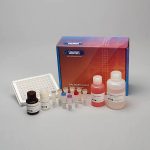- To obtain consistent results, it is important to always use the same methods, equipment, timing, etc., when testing saliva samples.
- Salimetrics recommends that all saliva samples be frozen, thawed and centrifuged before use in our assays. (Freezing precipitates particulate matter and mucins.) Note: This process must be repeated every time a sample is refrozen, as freezing causes new precipitates each time.
- All reagents and plate strips must be at room temperature before testing. Reagents in a 60 mL bottle need a minimum of 2 hours, 24 mL – 1.5 hours, plate strips – 30 minutes. It is recommended that plates be at room temperature when opened as detrimental condensation can collect on the cold well surfaces.
- Once pipetting of standards, controls and unknown samples onto the plate has begun, do not stop until all the samples and the diluted conjugate solution has been added and the timer has been started. Change pipette tips between each different standard, control or unknown. (It should not take more than 20 minutes to add all the samples to the plate wells.)
- Be consistent in your timing during an assay. For example, have the timer set for incubation periods before adding reagents. Then start the timer as soon as you have finished dispensing reagent onto the plate, or as soon as you begin to add reagents. Do it the same way throughout your test.
- The temperature of your laboratory may affect assays. Keep the laboratory temperature consistent.
- All pipettes used in the process of testing should be checked routinely for accuracy and precision. Consult the manufacturer’s pipette calibration instructions.
- It is best to use a multichannel pipette that works well for you and to consistently use it, as long as it is in good working condition and is within your laboratories specifications for accuracy and precision. (Single channel pipettes are not recommended for the addition of reagents.)
- When using a multichannel pipette it is important to follow the same sequence and timing when adding additional reagents so that the incubation time is the same for all wells.
- Always use the reagents specified for the kit being used. Lot numbers of reagents should not be mixed!
- We recommend standards and controls be used as follows, being careful to avoid contamination:
- Each vial may be used up to 3 times, within one month of first usage. Then discard.
- 1X Wash should be made ‘fresh’ daily. Discard any remaining unused wash at the end of the day.
- A 1 minute soak is recommended during the next to the last wash step to promote better results.
- Blot plates after washing. (Do not allow the wells to dry completely before adding next reagent.)
- If a technician is undergoing hormone replacement therapy that involves the use of topical gels, such use could potentially contaminate the assays rendering the results invalid. Also antibacterial soaps, lotions, and hand sanitizers should not be used by techs as they can interfere with assays.
- A dual wavelength reading using a reference and correction filter is recommended for the best results though it is not required. Read the plate with the filter that measures the maximum optical density. Read again at a secondary wavelength. Subtract this wavelength from the primary filter reading. This corrects for optical interference.
Ver. 1, 06-09-17
 Contact: Salimetrics (USA)
Contact: Salimetrics (USA)
